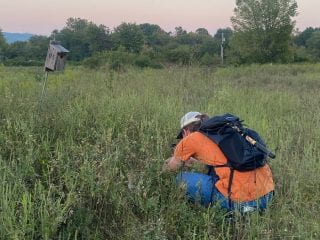Andrew Ruegsegger Documents Over 100 Plant Species at the U of A’s Oak Knoll

Andrew Ruegsegger scoured the Oak Knoll during the fall 2023 semester to document the flora of the site.
Over several weeks during the fall 2023 semester, Andrew Ruegsegger spent much of his free time exploring a small, undeveloped area on the south end of campus in search of plants.
Ruegsegger, a fourth-year undergraduate student majoring in anthropology and minoring in philosophy, biology and natural resources management at the U of A, was interested in learning more about botany, diverse native plant communities of the area and the process botanists use to document plants by collecting and preserving specimens in a herbarium.
So he enrolled in research credit hours with Jennifer Ogle, botanist and collections manager of the U of A Herbarium in the Department of Biological Sciences, and got right to work scouring the Oak Knoll for specimens to collect.
The Oak Knoll, named for the mature post and blackjack oaks that dot a picturesque hill near the center of the site, sits on the south edge of campus and features several distinct but intertwined naturally occurring habitats, including the oak savanna on the hill but also tallgrass prairie, forested and open wetlands, dry upland woodlands and a large stream, in addition to disturbed areas such as fallow pastures, fencerows and trail edges.
Ruegsegger was drawn to the site, not only for the diversity of habitats that occur there, but also because the tallgrass prairie and oak savanna, once common in the region, are exceedingly rare today. “In the early 1800s, surveyors from the General Land Office surveyed this region and mapped more than 4,000 acres of continuous tallgrass prairie just in the area around present-day south Fayetteville. This prairie extended north to Bud Walton Arena, south to Drake Field, west to Kessler Mountain Regional Park, and east to Combs Park. Today, less than 15 acres of that ancient prairie survive, at two separate sites — one of which is the Oak Knoll,” Ogle explained.
“These habitats are what much of Fayetteville and the wider Northwest Arkansas area once consisted of. Historically, bison and elk roamed and grazed here, and natural and anthropogenic fires maintained the prairie and savanna habitats in an open condition. But with the rapid development of the region, encroachment of invasive plant species and the absence of grazing pressure and fire, most of these habitats have been lost, and what remain are highly fragmented, small pieces called remnants. These areas are special because they represent native historical floral and faunal assemblages and are often hotspots for biodiversity,” Ruegsegger said.
To document the flora of the Oak Knoll, Ruegsegger borrowed a plant press and other collection supplies from the herbarium and used those tools to preserve plants he found at the site. To fulfill the requirements of the course, he only took plants that were either in flower or fruit when they were collected, and he made sure to only collect an entire plant by the roots when that species was abundant at the site.
He collected both native and non-native plants, but all were growing outside of cultivation. To keep track of all the plants he found, Ruegsegger kept meticulous notes that included the date each plant was collected, a detailed description of the habitat, associated plants found nearby, GPS coordinates and information about the plant’s appearance that might be lost once it was collected and dried. He learned botanical terminology so he could use dichotomous keys to identify the plants to species, and he also learned how to use the herbarium collection as an identification resource.
By the end of his study, Ruegsegger had collected, pressed, identified and created labels for more than 100 species of plants from the site. The specimens will be deposited at the U of A Herbarium, where they will serve as vouchers of the flora at the Oak Knoll and could be used for a variety of research projects in the future.
“It has been extremely fulfilling having the opportunity to document this area over the last few months as an aspiring botanist and conservationist. It has given me the chance to get hands-on experience with collection practices, plant identification, herbarium work and to see first-hand how biodiversity is influenced by management practices (or lack thereof), disturbance and history,” Ruegsegger said.
“Projects such as Andrew’s are critical for documenting biodiversity and provide sound data on which to manage and restore threatened habitats, such as our rare prairie remnants,” said Maribeth Latvis, assistant professor in the Department of Biological Sciences and director of the herbarium. “It’s very rewarding for the UARK Herbarium to work closely with young professionals who are passionate about conservation and keen on learning botanical skills. There is much work to be done, and I’d like to see more projects like this.”
This story also appeared in the University of Arkansas News publication.

